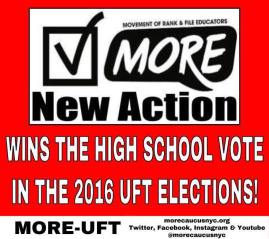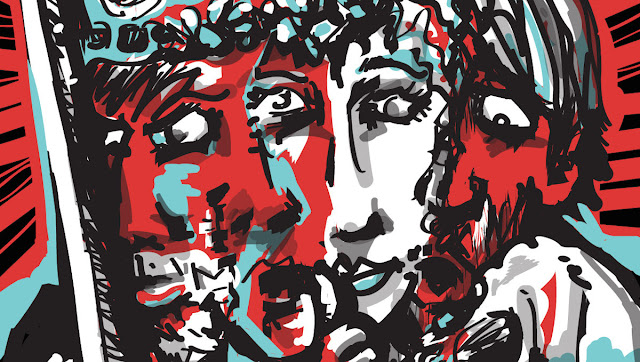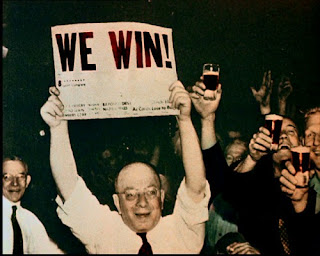I'm doing a series of articles related to the UFT election from the caucus perspective because I feel there is a need for a historical record that may prove useful in the future. I want to get it all down before I don't remember who I am. As always this is my personal account based on MY memories, which may not always be accurate. So feel free to correct me or disagree.
In Part 1 (
UFT Elections: Winning the High Schools - Part 1)
I focused on the actions of Arthur Goldstein and James Eterno and credited the work of them and Mike Schirtzer and the New Action alliance with being the difference. In Part 2 I'll review some of the longer range thinking going back to the July 2014 MORE retreat. Part 3 will take us through the fall of 2015. Part 4 - how candidates were selected, who are they, the campaign itself, what worked and what didn't. Part 5 will look ahead to what skills and political points of view do these candidates bring to the UFT Exec Bd. etc. And also - is it all worth it?
Due to my verbosity and lack of organized clarity, there will be a lot of overlap throughout the series.
Part 2: Winning the High Schools: the MORE Retreat, July 2014
The MORE summer 6 hour retreat took place 14 months after the 2013 election to discuss goals for the upcoming school year and to reflect on the past year.
The 2014/15 school year would include the spring 2015 chapter leader elections, which were deemed a crucial arena, the outcome of which would influence the general MORE 2016 elections. MORE would need a major push to recruit and assist those willing to run.
In the 2013 UFT election the MORE HS Ex Bd slate finished only 150 votes behind Unity, which was somewhat of a shock. If the 440 New Action HS votes had not gone to Unity but to us we would have won. (See
"The New Action conundrum" in Afterburn below.)
The retreat took place a few months after MORE was deeply involved in 2 major events in the spring of 2014.
MORE, Stronger Together, the 2014 contract
Running with
Stronger Together in the NYSUT leadership election with Arthur Goldstein as the VP candidate and a slate of 5 NYSUT district delegates - James Eterno, Julie Cavanagh, Jia Lee, Lauren Cohen, Mike Schirtzer and Francesco Portelos.
The
2014 UFT contract battle where 25% voted against with an over 90% turnout (Note that about 25% voted for MORE/NA in the 2016 election.)
We learned a few things from both battles. There was resistance internally in MORE to running in the NYSUT election -- about a 50-50 split in a vote taken at a meeting. An online re-vote was called for but if the vote went against then the pro-election faction could then run without MORE endorsement. Seeing there was a split down the middle, the faction opposing the participation cancelled the online vote. A similar ideological difference of opinion within MORE has come up on other issues --- basically, how differing people view what form a caucus in the UFT should take.
Their argument against running with ST left some people scratching their heads but it reflected a political point of view and analysis that running in union elections without a base was a "run from the top" strategy that would have little political impact. This was especially true in the NYSUT elections because they involved local union leaderships, not the rank and file.
A counter argument was that many of these local union leaders involved in Stronger Together were not like the UFT leadership which is separated from their members but people who are active teachers. That running would create alliances around the state. That running would help establish a greater presence for MORE and also be an opportunity to present MORE positions since we would get speaking time at the NYSUT convention.
The outcome of the NYSUT convention was positive for MORE and built the leadership skills of people like Lauren Cohen and Mike Schirtzer who spoke at the convention to represent MORE (
Video - NYSUT Update: MORE's Lauren Cohen and Mike Schirtzer Rock the House).
The rest of the MORE team, including Francesco Portelos who was on the MORE steering committee, worked well together and with the ST folks over the few days at the convention. Portelos would leave MORE to form Solidarity 4 months later. But more of that another time.
Participating with ST in the NYSUT election had such an energizing effect on MORE, the faction that originally opposed running later came around retroactively and felt it was the right thing to do. (At a future point I will get into more details on the factions in MORE because the story is illuminating.) MORE established a firm relationship with many people outside the city and with opt-out growing around the state, a previously unknown Jia Lee was beginning to become a strong presence. With Julie focused on her child and her work in her school, new leadership was emerging in MORE.
Contract battle, May 2014
On the contract battle we learned a few lessons.
We put out articles, press releases and held widely attended workshops and happy hours and one main meeting, some of the best attended MORE events.
While we were well-organized at that DA at the NY Hilton and came out in force, we learned about limits to what we could accomplish. With Julie Cavanagh next to speak at the mic, Mulgrew closed debate.
We held a poorly organized press conference right after the DA vote and
the distribution net to the schools which should have had in place as a
result of the 2013 election was disorganized and somewhat inept.
But even if we were better organized we would not have affected the contract vote outcome very much more than we did. We just didn't have enough active people, a lesson in itself. What did happen after Unity CLs pushed contract vote was that some teachers who had never been active in union politics who were in schools with Unity CLs ended up finding MORE and have become active in the group. For me the spotty performance of MORE in the contract fight was a disappointment - but I viewed that as growing pains for a fairly new caucus.
The Retreat: Do we want to win the high school Ex Bd seats in the 2016 election?
Early in the 2014 MORE retreat I asked: Does MORE want to win the high school seats in the 2016 election? If the answer was YES then MORE high school teachers would need to focus their attention on a campaign to make that happen and that campaign needed to begin in Sept. 2014, a year and a half before the election got started.
There was a mixed response. Some of the same ones who opposed the NYSUT election run a few months before felt that MORE should not fall into a high school only trap where the middle and elementary schools were left behind. That winning only a tiny sliver of 7 seats out of 100 would not bear fruit and would not lead to bottom up organizing.
The New Action example - they won high schools repeatedly in the 90s, then what?
After all, New Action had been there, done that throughout the 90s and ended up in their infamous arrangement with Unity after the 2001 election. They never made inroads into the other divisions to the extent that they could seriously challenge Unity. Doomed in perpetuity to holding a minority stake, NA opted to accept Randi's offer of a seat at the table. The NA decision led to their losing the bulk of even the limited support they enjoyed in 2001 where they garnered around 3000 votes in the high schools alone. A pretty deep drop in 12 years to 440 votes in 2013.
What if MORE won?
I and others made the argument that even if we won these seats what exactly would be do with them? And do we put up our strongest MORE activists who help keep MORE running to focus their attention on an Ex Bd meeting every 2 weeks in a room full of Unity slugs who will vote as one? I had seen ICE from 2004-7 when we had those seats focus a lot of attention - and James Eterno can point to some successes there.
Maybe there were successes but not in any way that helped ICE grow. The outcome after the 2007 election when we didn't win the seats was a quick decline of ICE that lasted right through the 2010 election, which I opposed ICE running in for that very reason. I don't believe in even trying to engage in an election unless you are building enough of a base to actually be able to govern if you should ever win.
At the retreat, I offered an idea that MORE should look to people who are not deep into the work of MORE and broaden the voices on the Ex Bd beyond MORE. I pointed to Arthur Goldstein who after his run for NYSUT VP was enthusiastic about running with MORE for the Ex Bd but was not active in MORE. He was very willing to put his energies into the EB. [In the 2016 election it turned out that of the 5 MORE people elected, only Mike Schirtzer has been deep into running MORE over the past few years - I urged him not to run because I felt he should focus on the work in MORE - though Ashraya Gupta has joined the most recent Steering committee.] There was some pushback from people who thought that there should be a strong commitment to MORE if the caucus was going to be the instrument of getting a seat on the Ex Bd. I said frankly that without Arthur we wouldn't win and since he probably agreed with 90% of MORE positions things could be worked out -- but there could be no loyalty oaths or restrictions on what issues he would want to raise. Only a promise to support any MORE initiatives unless there was an issue he could not in all conscience support.
At the retreat Mike Schirtzer agreed with me and also offered a strong case for aiming to win the high schools. He said that an opposition must try to show a win at some point and given the high school numbers in the 2013 election MORE had a shot even with New Action on the side of Unity. Winning in 2016, even with all the pitfalls presented, would give the opposition some momentum and also demonstrate MORE's organizational capability.
Mike expressed the thought that he and others are in this to win not to just make ideological brownie points. He would not be involved otherwise.
We were working under the assumption that summer of 2014 that New Action would continue supporting Unity and that their total vote of around 2000 HS votes together would hold up and it would be optimal if we would need to almost double our 1440. 2500 seemed a more reasonable number to guarantee an absolute win even if Unity increased its vote. That would take a major outreach to the high schools beginning early in the upcoming school year.
Mike offered a proposal. That MORE would make the goal of winning the high school seats a priority, in addition to focusing on the recruitment and training of prospective chapter leaders during the school year.
The proposal passed. I offered a plan - that we form a high school committee that would aim at the 50 largest high schools, with borough captains and that MORE begin the spring 2016 campaign in the fall of 2014 by producing a newsletter and developing a potent distribution network to try to reach rank and file on a regular basis, not only during election time every 3 years. What about the elementary and middle schools? I felt that the high school people should work on the high schools and the other divisional people who were district based should focus on their divisions locally and build their networks out. I offered to take charge of the newsletter and to organize a high school committee.
In August I put together a newsletter for general distribution and had it ready as September began. I began planning on organizing the high school committee and had conversations with some key people. We distributed the newsletter as the school year began.
In mid-late August, internal strife from a number of directions began to hit MORE. By the end of September/early October, MORE stopped functioning organizationally. 3 members, including Portelos, had resigned from the Steering Committee over various issues. I ceased working on the newsletter and the high school committee.
It wasn't until January 2015 that MORE began to come back, partially motivated by the idea that the chance to win the high schools, with the election season a year away, was slipping away. Part 3 will delve into the details.
Afterburn
The New Action conundrum
Back in November 2013, 6 months after the UFT election, at a meeting with some members of New Action to address requests to work together on some projects, Julie Cavanagh and I, as the MORE reps, made the point that we could never work with New Action on any basis until they broke with Unity and also pointed out that if they did break with Unity, together we could win the high schools seats in the 2016 election plus find other synergy (I can't believe I'm using corporate speak).
I said then that just a look at the demographics of MORE and New Action indicated where things were headed and not in the direction of New Action. I offered up the example of ICE, another aging caucus, which was no longer an active caucus competing with MORE. Or how TJC had disbanded to join MORE. I was not talking about a merger of even an election alliance but as an invitation for New Action people to get involved directly in helping build MORE. [Some New Action people disagree with some of my interpretations but there is a tape of the meeting.]
A big tent caucus, with all its trials and tribulations is still my goal.
How can we expect the membership to trust us to run the union of we can't demonstrate we can co-exist in one caucus instead of splitting into multiple caucuses?
I and some others view the recent election alliance as a necessary step in moving toward one big tent caucus.
I will do some historical based posts on why multiple caucuses coming together every 3 years for elections had been a failure over the past 4 decades. A prime example: New Action formed in 1995 when the 2 leading opposition groups, Teachers Action Caucus and New Directions, merged.







